Reaction to urban boundary question in Hamilton is so big that council postpones decision
Councillors will decide later this month after 80 presentations and hundreds of letters

Hamilton politicians haveput off a major decision on expandingthe city's urban boundary after about80residents gave presentations and hundreds more wrote letters, resulting in a meeting that went on for more than 12 hours.
City councillors voted Tuesday evening to defer the vote to later this month. So it will be at least Nov. 19 before they decide whether to expand Hamilton's urban boundary toadd 1,310 of countryside.
The decision came after hours of live delegationsand ahead of another two hours of video presentations. Some delegates were developers, realtors, planners and business people who want the expansion. More were residents, farmers and other planners who urged the city to find ways to build on existing land.
Don McLean, founder of the local watchdog Citizens at City Hall (CATCH), said the interest is a new era of engagement.
"This is a dramatic shift in my community, and I'm over the moon about it," he said in his presentation.
It was Mayor Fred Eisenberger's idea to recess the general issues committeemeeting until later this month, saying their minds were getting too foggyto make good decisions.

"This is a big, important issue and we're all serious about it," he said.
"We need to be fresh and of clear mind when we deal with this the next time."
The city is provincially mandated to look at how it will accommodate aprojected growth of 110,300 households by 2051. Theissue at hand is how to do that.
There are two options: an "ambitious density" scenario that would seeinfill as well as a boundary expansion, and infill with no urban boundary expansion. City planning staff recommend the first option.
With the ambitious density option, 25 per cent of future housing would be detached single-family homes, 25 per cent townhouses and 50 per cent apartments. With the second, nine per cent of new housing would be single-family homes, 13 per cent townhouses and 78 per cent apartments.

Proponents of the first option say an expansion is necessary to provide a range of housing choices. Opponents say it's expensive, environmentally destructive, androbs the area of precious food-growing land.
The latter includes Drew Spoelstra, Binbrook farmer and vice-president of the Ontario Federation of Agriculture (OFA).
Spoelstra told councillors Tuesday thatfarmland in Elfrida, on the southeastern edge ofHamilton,is some of the finest and most productive in Ontario.
"The province is already losing 75 acres of farmland a day," Spoelstra said during his presentation. And "not all land is suitable for farming in the greenbelt."
Spoelstra, who also chairs the city agriculture and rural affairs advisory committee,said the province's planning policydictates that farmland be protected. So the city should abide by that, he said.
On the plus side, "I don't think I've seen folks talk about agriculture in the last 20 years as much as they have in the last few months."

Meanwhile, the Hamilton Chamber of Commerce saidif council doesn't expand the boundary, the province could impose it.
Policy advisor PaulSzachlewiczsaidHamilton's "housing affordability challenges" arebarriers for local employers to recruit workers.
Cheryll Case, a planner, sessional professor and author ofHouse Divided: How the Missing Middle Will Solve Toronto's Affordability Crisis, said Hamilton's density targets could be met through building on existing urban land. This includes building inso-called "yellowbelt"land neighbourhoods with severe development restrictions where more units can be built.
Developer Danny Gabriele from Marz Homesrefuted that, saying the expansion is necessary as "the housing deficit gets deeper and deeper."
During the presentations, Coun. Brad Clark (Ward 9, upper Stoney Creek) wondered aloud if expanding the boundary would do anything to make housing more affordable.
In his ward, houses are "poppingup like toast in a toaster and the pricing has not come down," he said. "It's shot through the roof."
Planning staff propose adding 305 hectares from 2021 to 2031, 570 hectares from 2031 to 2041, and 435 hectares from 2041 to 2051.
If approved, the city would hammer out the details between now and the spring, with a final plan submitted to the province in June.
The city has had two urban boundary expansions in recent years the airport employment growth district, and the Stoney Creek urban boundary expansion, otherwise known as SCUBE.













_(720p).jpg)


 OFFICIAL HD MUSIC VIDEO.jpg)
.jpg)



























































































